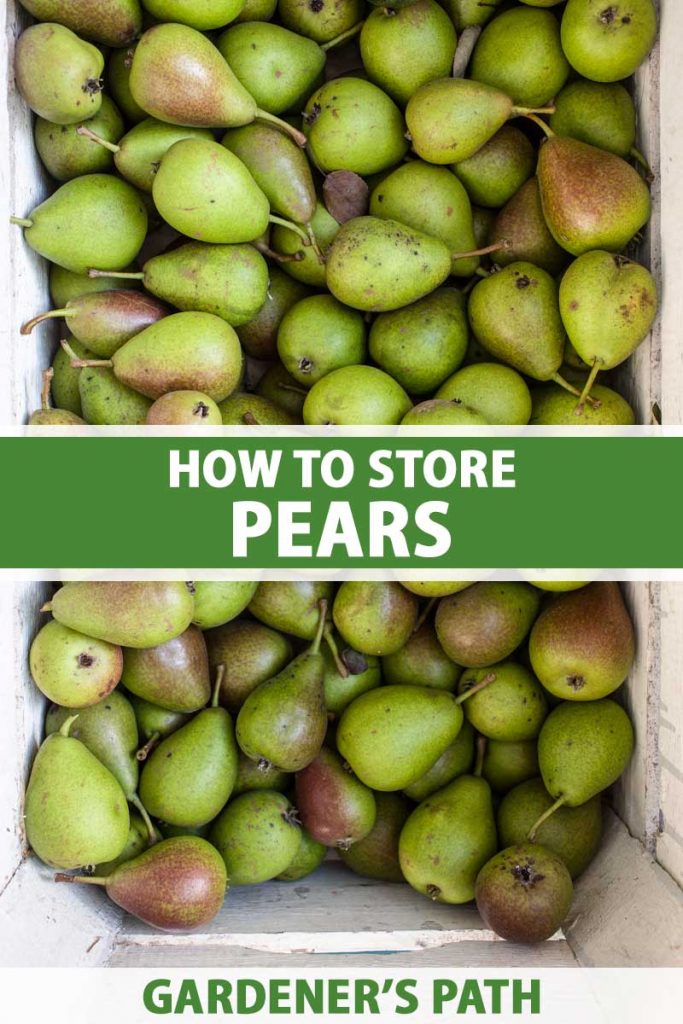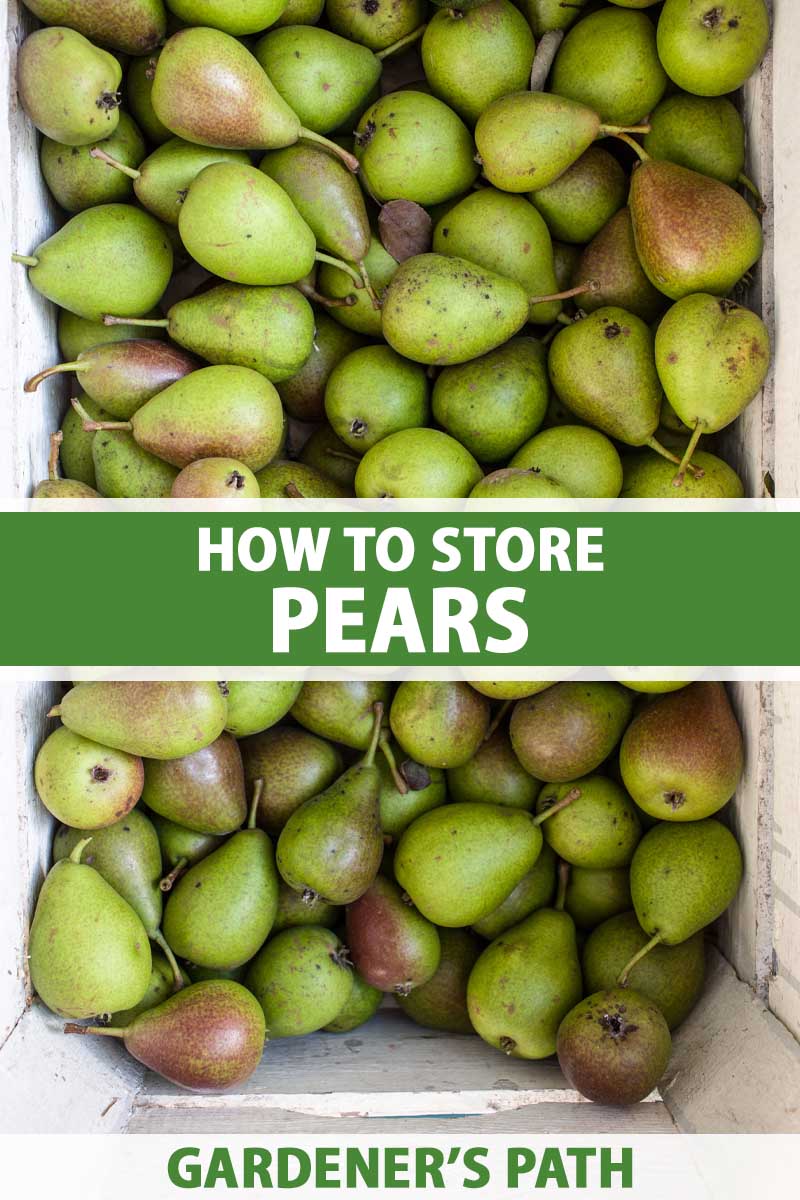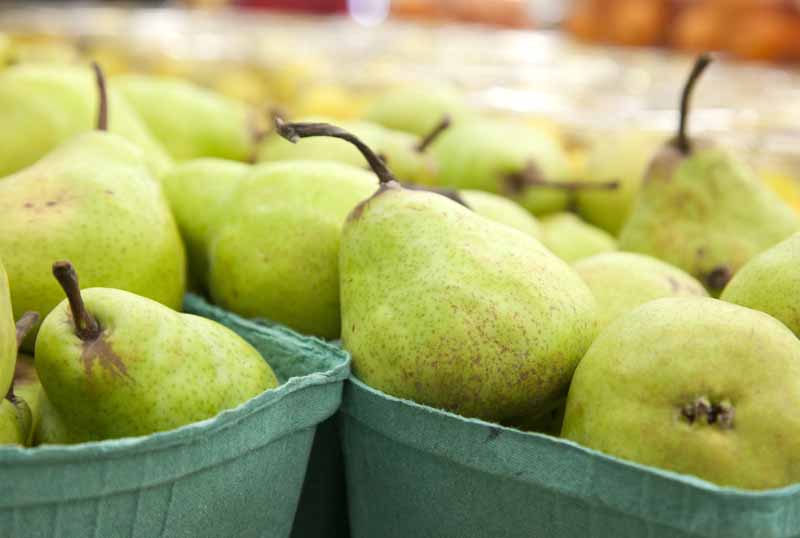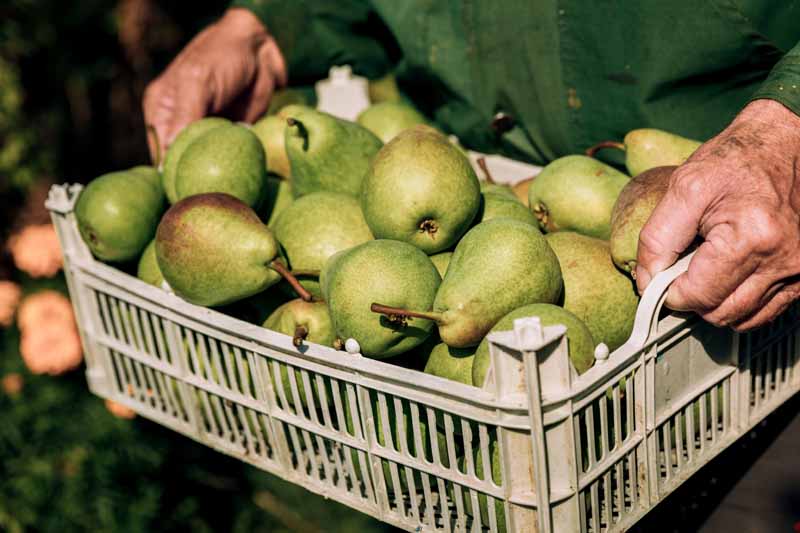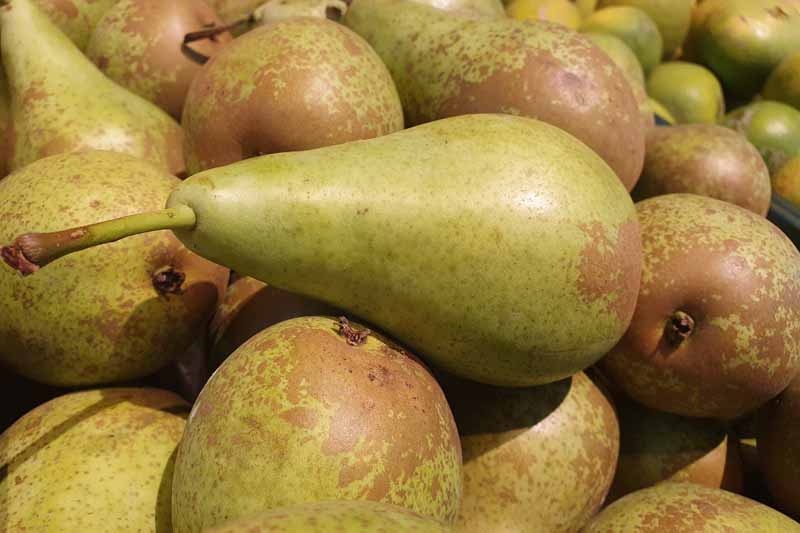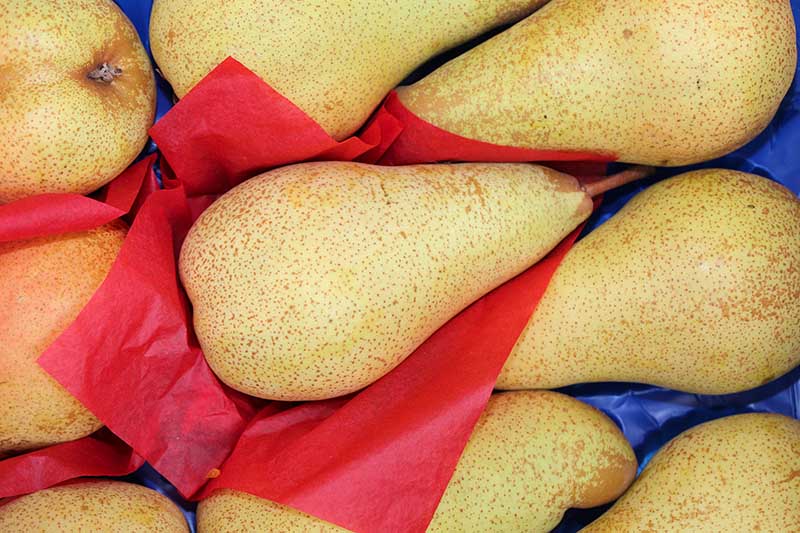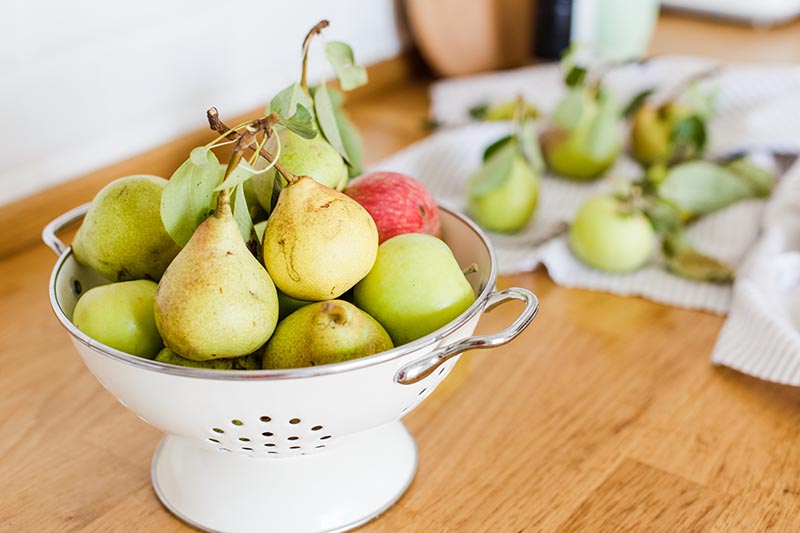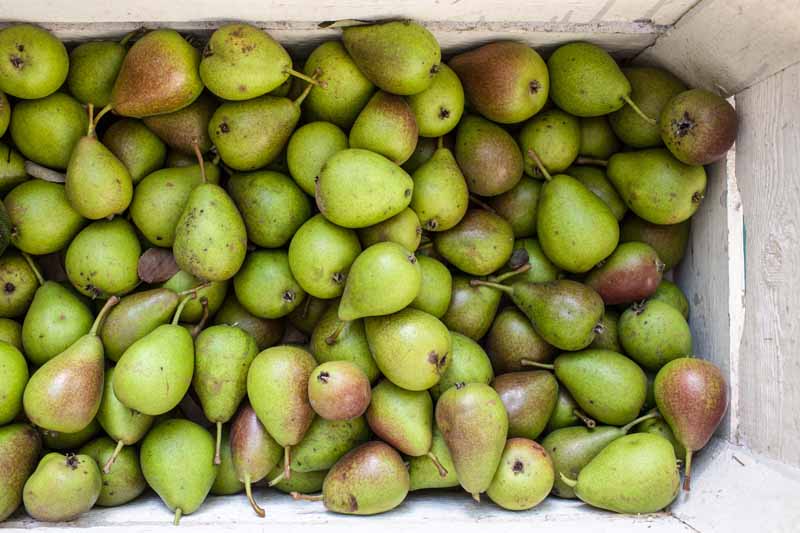Fragrant and flavorful, they’re wonderful for fresh eating, desserts, or made up into preserves. Harvested from mid-summer to mid-fall, depending on the cultivar, many varieties make excellent keepers and can be stored for months given the right conditions. We link to vendors to help you find relevant products. If you buy from one of our links, we may earn a commission. And they need to be handled gently to avoid damaging the soft-skinned flesh. If you’re a pear fan (and who isn’t?), here’s everything you need to know about how to handle and store your pear harvest.
Two Types of Pear
Pears belong to the genus Pyrus, and two species are grown for consumption. The familiar, soft-fleshed European (P. communis) varieties have a juicy, buttery texture and classic teardrop shape.
A more recent option for home gardeners is the crisp-fleshed Asian (P. pyrifolia) varieties that have a crunchy texture and a round shape much like that of apples. European cultivars fall into two categories based on their harvest time: summer and winter pears, and this will determine how you store and ripen them. Summer varieties don’t require a period of cold storage before ripening. But the only summer variety that stores well is ‘Bartlett,’ which can be kept for one to two months. And for best quality, winter varieties like ‘Anjou,’ ‘Bosc,’ and ‘Comice’ require four to eight weeks of cold storage before they’re ripened. The cold inhibits the ripening process and allows the fruit to develop better texture and flavor. The fruit of Asian trees are simply allowed to mature and ripen on the branch, and are juicy and crisp when eaten freshly picked from the spur. They do moderately well in cold storage, but typically only keep for up to three months.
Picking Fruit
Unfortunately, unlike Asian types or apples, the fruit of European cultivars do not fare well when allowed to ripen on the branch. They ripen from the inside out and have a tendency to develop a coarse, mealy texture, and suffer from core collapse – where the fruit rots from the inside – so fruits are harvested when they’re mature, but not yet ripe.
Maturity is defined as ready to pick, but the fruit is typically still green and hard, depending on the cultivar. Ripe means they’re ready to eat. So how do you know when they are ready to pick? As the expected harvest date approaches, start to watch your pears closely. In most cases, you can tell that a fruit is mature when it releases readily from the branch. To test this, lift the hanging fruit to a horizontal position – if it releases easily, it’s mature. Unless it’s a ‘Bosc,’ which are known to be stubborn about letting go of the branch.
Some varieties, like ‘Anjou’ and ‘Bartlett,’ change color slightly at maturity, going from dark green to a lighter shade or develop a rosy blush on the side that’s exposed to the most sunlight. At the same time, pores in the skin called lenticels may become more noticeable. If fruit has already started to drop from the branches, harvest promptly. They may be past their prime for fresh eating, but much of the crop can still be salvaged for canning, jams, and other preserves. Fruit growing at the top of trees and on limb ends usually mature a little earlier than those in the center. However, keep in mind that none of the above applies to Asian pears, which mature and ripen on the tree. As Asian cultivars mature, fruits can change color from an underripe green to shades of gold, russet, or yellow, depending on the cultivar. Allow these varieties to ripen on the branch, and sample for taste as they change color, as you would an apple. Asian types don’t need to be picked all at once, which makes harvest time a bit more manageable. However, when left on the spur too long, they tend to develop a lightly fermented, alcoholic flavor. Learn more about when and how to harvest pears in our guide.
Cold Storage
Fruit should be stored immediately after picking. Separate out any bruised or damaged fruits, those without a stem, and any that have started to ripen.
As mentioned, summer varieties do not store well – with the exception of ‘Bartlett’ that may keep for up to two months. Asian types can be stored as described below and used within three months. Choose a shallow cardboard or wooden box and cut out a few ventilation slots on each side if needed. Insulate the box with crumpled newsprint. For winter varieties that require a period of cold storage prior to ripening, wrap the fruit lightly in tissue paper.
Place the fruit carefully in the box in a single layer, and handle them gently to avoid bruising. Space them so that the fruit is not touching. To maximize storage time, the ideal temperature is 30-32°F with a humidity of 85 to 90 percent. In these conditions, pears will keep from two to six months, depending on the variety. An old refrigerator is perfect for this purpose, but an unheated cellar, garage, or shed also works – provided air circulation is good and temperatures remain in the range of 30 to 40°F. But warmer temperatures will also mean significantly reduced storage length. If temperatures drop to 29°F or below, the fruit will freeze and your harvest will be ruined. Check your fruit on a regular basis, and discard those that develop mold or overly soft flesh. Remove any that begin to ripen – or in the case of Asian types, those that are overripe – and use in the kitchen immediately. Avoid storing your pears close to strong-smelling produce like garlic as the fruit can absorb these odors.
How to Ripen
After winter pears have been cold conditioned, they need to ripen before you can eat them. To ripen, bring the fruit out of cold storage and into room temperature (60-70°F). You can place them in a bowl on a countertop and they should ripen in three to 10 days.
To speed up ripening, you can add a ripe apple, avocado, or banana to the bowl. They release ethylene gas which accelerates the ripening process. You can also place a few in a loosely closed paper bag which can help to speed up ripening. Fruit is ripe when the stem flesh just above the shoulders yields gently to pressure. If the flesh is still hard, allow them to ripen for a few more days. To ripen more slowly, you can put your pears in a loosely sealed plastic bag and place in a slightly cooler area, with temperatures between 45 and 60°F. After ripening, fruit can be stored in the refrigerator but should be brought to room temperature before eating for the best flavor and texture.
Preserves
If you have a big harvest of ripe fruit, pears also make fantastic preserves. Try spicy homemade pear butter or jam, or slice and can them in a light syrup. Dehydrated, they make a sweet, chewy treat.
They can also be frozen in a light syrup or you can freeze peeled slices on a tray and transfer to freezer bags when solid. They tend to turn mushy when they defrost, so you’ll want to use them in baking or other recipes where texture isn’t important. And of course, they make an exceptionally fine wine! For more inspiration on how to use up your ripe fruit, check out these recipe ideas on our sister site, Foodal. For winter varieties, remember to keep storage temperatures as close to 31°F as you can. For summer and Asian varieties, you can eat them fresh as soon as they’re picked – but they’ll keep for a few months in the fridge or cold storage as well.
Do you folks have any pear storage or handling tips to share? Drop us a note in the comments below. And for more information on growing your own pears, you’ll need these guides next:
How to Grow Fruiting Pear Trees 11 of the Best Fruiting Pear Varieties to Grow at Home How to Propagate Pear Trees from Cuttings
© Ask the Experts, LLC. ALL RIGHTS RESERVED. See our TOS for more details. Product photos via Home Depot. Uncredited photos: Shutterstock.
